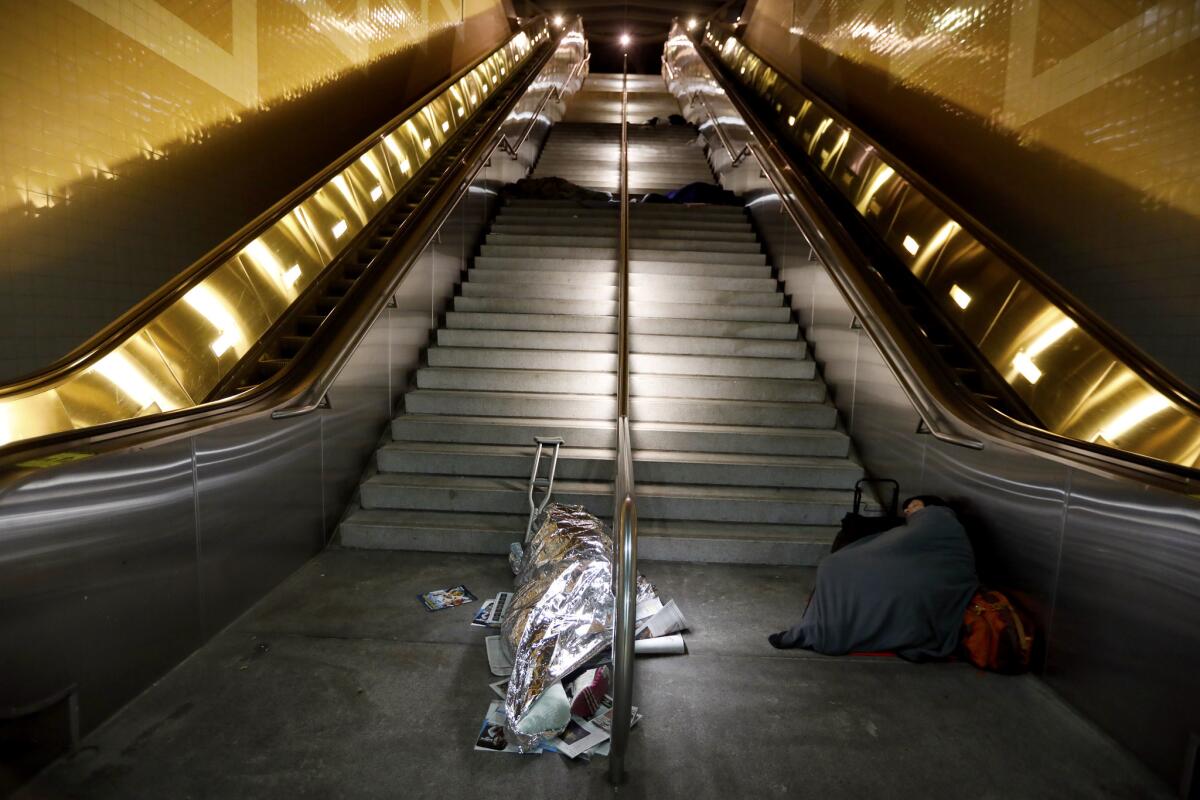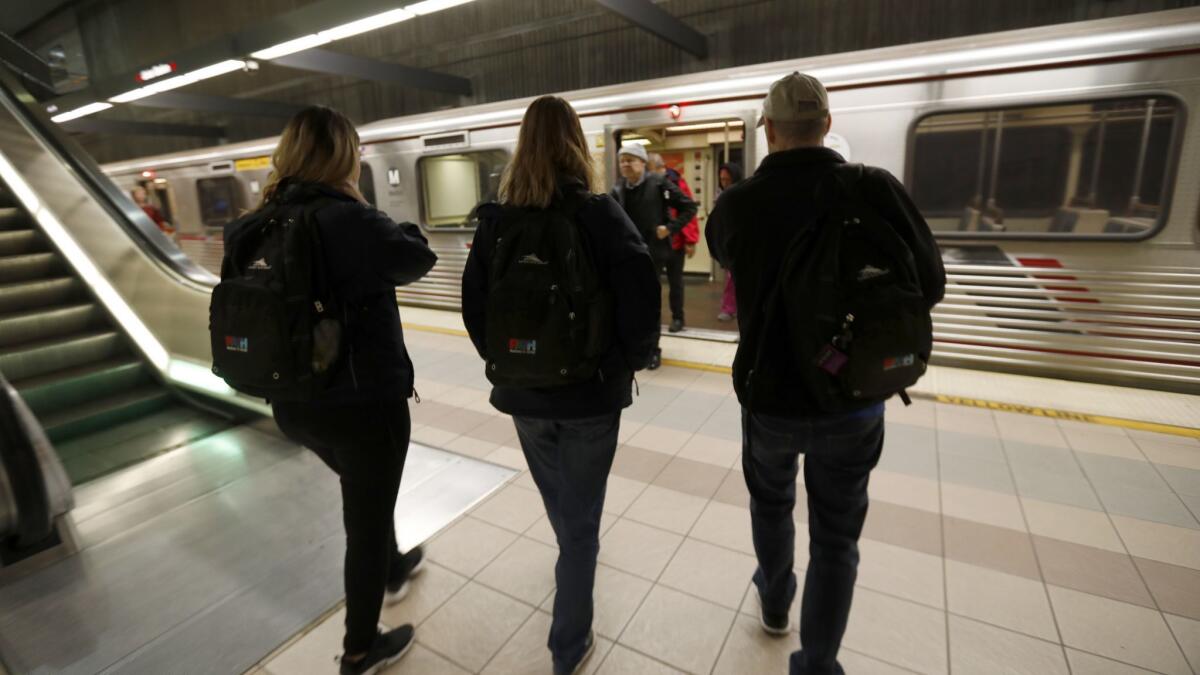As waves of homeless descend onto trains, L.A. tries a new strategy: social workers on the subway

- Share via
The early morning commuters stepping off the Metro escalator paid little attention to the 10 people huddled under blankets and curled up in corners at the Hollywood and Vine station.
John Gant, 60, lay sprawled on the tile floor, his hoodie drawn over his face. When three social workers stopped to ask if he wanted help, he nodded.
Over hot coffee and pages of paperwork, Gant, who had been homeless for years, called his mother to share the news. He cracked a rare smile, saying: “They’re trying to find me a place to sleep.”
The Metro system has been a refuge for homeless people for decades. But as Los Angeles County’s homeless population has surged, reaching more than 58,000 people last year, the sanitation and safety problems on trains and buses are approaching what officials and riders say are crisis levels.
People looking for warm, dry places to sleep have barricaded themselves inside emergency exit stairwells in stations, leaving behind trash and human waste. Elevator doors coated in urine have stuck shut. Mentally ill and high passengers have assaulted bus drivers and other riders.
This is a crisis. If we don’t get a handle on it, it’s going to keep growing.
— Los Angeles County Supervisor Hilda Solis at a recent Metro meeting



Amid a wave of complaints about homelessness, the Metropolitan Transportation Authority has bolstered spending on law enforcement and security by 37% this year. But the agency is testing a different approach, too: social workers on the subway.
Under a one-year, $1.2-million contract — one of the first of its kind in the country — outreach workers spend five days a week on the Metro Red Line, trying to help the system’s homeless riders.
It’s a modest sum for an agency with a $6.1-billion budget, though the program will probably expand. Whether the outreach workers’ efforts will retain current riders, or bring back those who have left, is unclear.
How Metro addresses homelessness is crucial to the agency’s future. A perception that trains and buses are dangerous or dirty could undercut Metro’s ambitious expansion plans, which call for the construction of nearly a dozen new rail lines over the next four decades.
“This is a crisis,” said Los Angeles County Supervisor Hilda Solis at a recent Metro meeting. “If we don’t get a handle on it, it’s going to keep growing.”
‘Filthy, noisy, scary’
Riders’ feelings about the safety of buses and trains have had a direct effect on ridership. More than 1 in 5 current passengers has been harassed on the train. In a 2016 survey, 29% of former riders told Metro they stopped taking transit because they felt unsafe.
“Too many homeless and not enough cops,” wrote one former rider, in survey responses reviewed by The Times. Others described their commutes as “filthy, noisy, scary” and “rather disturbing at times.”
There’s little solid data on how many homeless people use the transit system each day, and the region’s yearly count has not historically included rail stations, trains or buses.
But the scant available numbers are grim. One cold, rainy night in January, Los Angeles police swept 160 people from buses and trains on their final stops of the night. That figure dramatically understates the extent of the problem, officers say, because it does not include the lines that finish their runs in other cities.
Passengers who encounter chronic addiction, illness and misery say they feel they can do little to help, and struggle to stay empathetic when they encounter trash and human waste on platforms, urine in train cars, and harassment from riders who are mentally ill.


More photos: Scenes from homelessness »
“Week by week, it seems like it just gets worse,” said Sarah Caldwell Sim, who takes the Expo Line, the subway and the Gold Line to work in a Cypress Park factory. “My frustration with what I see is turning me into someone that I’m not. I’m really struggling with this.”
Sim said she saw a man pull down his pants, squat over the edge of a platform and defecate onto the train tracks at Union Station. She said she has sat in urine on the subway, “hopscotched through peoples’ feces” on sidewalks, and endured verbal and sexual harassment on the train.
Metro doesn't need more security officers, Sim said, but the employees it does have should step in more often when something is wrong. When a homeless man followed an elderly woman across a Gold Line platform, screaming profanities, a guard dismissed the man as “a local” and did nothing, she said.
Her other suggestion: “Stop putting carpet on the seats.”
Metro budgeted nearly $207 million this fiscal year on law enforcement and system security. Policing on the system is shared between the Los Angeles and Long Beach police departments and the Sheriff’s Department, aided by private security guards who write citations for loitering, littering and fare evading.
The security contracts, approved last year, will cost Metro almost $800 million over five years.
On a sidewalk, officers can really take their time with someone, but we can’t just step off the train and let it continue.
— LAPD Deputy Chief Bob Green

Reports of violent crime — including rapes, assaults and robberies — fell 9% in 2017 compared with the previous year and total crime fell by 20%, according to the agencies. Officials attribute the decline to the new contracts, which nearly doubled the number of uniformed officers on the system.
Metro officials say that placing a police officer on every bus or at every station would be prohibitively expensive, and could intimidate some black and Latino riders, who have expressed concerns about racial profiling.
Passengers should never feel unsafe on Metro, officials say, and should soon see the effects of the costlier law enforcement contract, if they have not already.
The hope is that housing the homeless will reduce policing costs in the long term. But that progress could take years or decades.
“It feels like a tsunami of a crisis, where the water just keeps coming,” said Jennifer Loew, who oversees Metro’s homeless services contract. “We are having to temper our expectations of whether this can be solved overnight.”
Funding from Measure H, the quarter-cent sales tax approved in 2017, will pay for an additional 40 social workers who will split their time between the transit system and the county’s parks, beaches, harbors and libraries.
Directors have also asked Metro to study how to best expand the outreach program to some of the sprawling system’s bus lines, which carry 70% of riders. All-night buses on major thoroughfares face frequent issues with homeless riders, drivers say, including erratic and dangerous behavior.
“If you ride every day, you’re going to have those experiences more than once a year, maybe more than once a month or once a week,” said Los Angeles Mayor Eric Garcetti, who said he supports a dramatic expansion of the outreach program. “We can’t make those experiences zero overnight. But we have to make them fewer and fewer, until we eliminate them.”



Hundreds contacted, 19 permanently housed
Hiring social workers is a new step for transit agencies, where officials have traditionally dismissed homelessness as a societal problem that should be addressed through nonprofit organizations or other government programs, said Dan Boyle, a San Diego consultant who surveyed U.S. transit agencies on their approach to homelessness.
Boyle said a surge of complaints from riders is often the driving force for agencies to pursue new policies on homelessness. Hiring more law enforcement creates “a revolving door, where you sweep someone off the system and they’re back the next day,” he said, and many agencies eventually turn to partnerships with nonprofits.
Metro hired the nonprofit People Assisting The Homeless, or PATH. Since May, its outreach workers have conversed with more than 1,500 homeless people on the subway and placed 19 in permanent housing. They report that 237 others have been connected to programs that could lead to permanent housing.
Though 19 is “much lower than you'd want to hear,” Boyle said, the data show promise. Workers provided some form of aid, including rides to the doctor and help securing photo identification, to 821 people. Those relationships could later lead to housing, he said.
Some acutely ill homeless people have secured spots in the Department of Public Health’s Housing for Health program, which uses county and federal money to subsidize rents and pay for intensive case management.
Finding a shelter bed can be more challenging, because the facilities mostly fill up by 3 p.m., hours before people filter into stations to sleep.
Outreach workers use the story of Henry as an example of an immediate and early success. He left Arizona when his father was killed and his grandfather died. He wound up living in the Santa Ana riverbed, and then, when Orange County officials cleared the area, Union Station.
An outreach team found him at Union Station, tracked down his family in Arizona, and used funds from L.A. County’s rapid rehousing program to buy him a bus ticket, said Karen Barnes, a program manager for PATH.
But often, efforts to help the homeless can take months or years and still fail.
Many of Metro’s homeless riders have chosen the anonymity of a bus or a train over the community of an encampment or a shelter, outreach workers say. Some have not spoken to anyone in days or weeks, or vanish when they step on a train or a bus.
“We may never see them again,” Barnes said. “We have to build that rapport quickly.”

Unease over interactions with law enforcement
Law enforcement’s active role on the system can complicate the workers’ efforts to build relationships. Police officers and security guards often stop people from sleeping at stations, or ask them to leave if they don’t have a valid fare.
On a Monday in February just after 7 a.m., a Los Angeles police officer approached a woman sleeping near the ticketing machines at Union Station and turned his flashlight on and off in her face.
The woman, disheveled and angry, screamed that she had not slept all night. She brushed past the outreach workers nearby, refusing their offers of help.
Later that morning, on a crowded train in North Hollywood, Barnes sat down next to a young woman who was fast asleep with a duffel bag in her lap. A Metro security guard boarded the train, rapped her flashlight against the woman’s seat, and asked to see her fare.
Barnes intervened, saying: “Can you let us talk to her for a few minutes? We’re a homeless outreach team.”
Some interactions can leave homeless people permanently wary of police, including when officers forcibly remove someone from a train.
From July to December of last year, Los Angeles police reported 54 incidences of use of force on Metro. Half of those cases involved a homeless person, and in many cases, addiction or mental illness played a role, police said.
The use of force cases were “overwhelmingly” minor incidents where officers touched someone when they took them off a train, Deputy Chief Bob Green said. He said police are left with few good choices when someone is having a breakdown or threatening other passengers in an enclosed space.
“On a sidewalk, officers can really take their time with someone, but we can’t just step off the train and let it continue,” Green said. “They have to take some kind of action. It puts officers in a very difficult and delicate position.”
In one more serious case, Loew said, LAPD officers used a Taser on a man who was brandishing a knife and threatening passengers.
Metro’s security guards frequently move through stations, asking people to board a train or move along. After one such sweep at the Civic Center station, Barnes and her partner found Boyd Williams gathering up his belongings.
Formerly an oil and gas futures trader in Dallas, Williams developed alcoholism and abused his wife, he said. He became homeless, and moved to California five years ago for the weather. He lives in an encampment along Cesar Chavez Avenue, and frequently charges his phone at Metro stations.
“Living on the street, I didn’t realize the health problems were so rampant,” Williams said. Finding stable housing could be hard, he said, because he has a criminal record and is addicted to heroin.
Metro is also a year behind schedule in developing a policy on how to clear encampments on agency property, including in arroyos near the Gold Line and along the Harbor Freeway and Orange Line busways.
Officials said the agency cleaned five encampments in the last year without a policy in place, which could be a dicey legal position. In Los Angeles, legal settlements obtained by homeless advocates have created tightly controlled cleanups that are sometimes supervised by attorneys.
Metro’s cleanups stopped after the LAPD refused to oversee them without a formal policy in place, Loew said. But the agency still plans to clear any encampments that spring up too close to railroad tracks or other rights-of-way.
There will be a tentative legal decision within weeks, and a formal policy by September, Loew said.



‘There’s only so much we can take’
On a recent weekday, many residents of an encampment along the Orange Line busway scattered before the city’s tree-trimming trucks came through.
One resident, a man with unkempt hair and wild eyes, left the encampment and sat on a bench at the Van Nuys station, clutching his stomach.
Carmen Arboles approached and offered him a McDonald’s gift card, which she carries to give to people who seem like they could use a meal. She said she tries to be kind to homeless people on the line to set an example for her kids.
“We want to raise them to help people and to be kind,” Arboles said. “But it’s hard when there are so many people who need help.”
Outside the station, a long line formed outside the public toilet on the sidewalk — one of the few available in the San Fernando Valley.
Faced with complaints about defecation and urination on vehicles and in stations, Metro's directors have begun to question whether the agency should build more public bathrooms. The lack of toilets across the system is a source of discomfort for riders with long commutes, and one reason seats, trash cans and elevators wind up soaked in urine.
“If we don’t want the consequences, then we have to offer the solution,” said Duarte mayor and Metro director John Fasana. But, he said, keeping the facilities clean and safe would come at a significant cost.
In 2010, the W Hotel on Hollywood Boulevard opened a public bathroom next to the subway station. After replacing three sinks, three mirrors, and five toilet seats in three and a half months, and spending an average of $250 a day on paper products, the hotel closed the facility, officials said.
If more bathrooms led to less urine on trains, Trevor Barajas might start riding again.
For more than five years, Barajas caught the 5:59 a.m. train from North Hollywood to his mechanic job near downtown. He said he tried to “peacefully coexist” with the high concentration of homeless riders, who board trains in the early morning to warm up after a night spent outside. Sometimes, he packed peanut butter sandwiches to share.
But recently, he said, the trains seemed dirtier and more chaotic. Some riders began spraying perfume and air fresheners to neutralize odors. Others brought magazines to sit on.
He kept riding, until he sat down one morning on a seat that was wet and hot with urine. With no change of clothes on hand, he wore the urine-soaked pants to work. Then he started driving to work again.
“There’s only so much we can take,” Barajas said. “At least I can sit in my car without worrying what I’m sitting in.”
Twitter: @laura_nelson
Sign up for Essential California
The most important California stories and recommendations in your inbox every morning.
You may occasionally receive promotional content from the Los Angeles Times.








